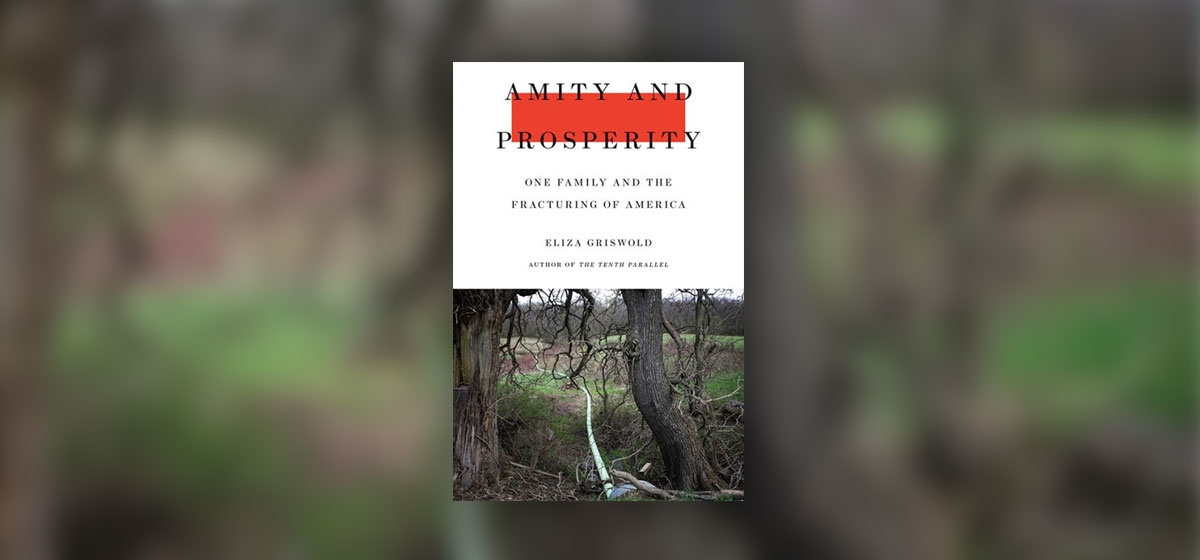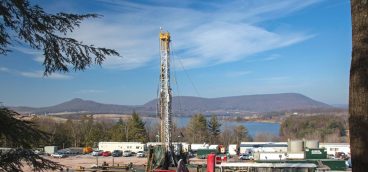An Elegy of the Marcellus Shale region

When U.S. Environmental Protection Agency Acting Administrator Andrew Wheeler visited Pittsburgh on October 24 last year, his first order of business was to visit a Range Resources well-pad outside Washington, Pa., announcing that the EPA would continue “removing regulatory barriers and leveling the playing field for American companies.”
Politicians, billboards and commercials on local TV have for several years touted the economic benefits and energy independence the natural gas industry delivers. Some 29,000 oil and gas jobs have been created in Pennsylvania alone. But the work of extracting natural resources can forever change the landscape in rural areas where it happens. And the human cost to those living nearby has been difficult to tally.
Writer and poet Eliza Griswold’s absorbing new non-fiction book, “Amity and Prosperity: One Family and the Fracturing of America” assesses the fallout by focusing on the deeply-affected Haney and Voyles families in our southwest corner of Pennsylvania. Griswold, prize-winning author of “The Tenth Parallel: Dispatches from the Fault Line Between Christianity and Islam,” is a Distinguished Writer in Residence at New York University. The book was seven years in the making, In “A Note on Sources,” she says the “book was born in Nigeria in 2007 after a bridge collapsed… I decided it was time to come home, to turn my attention to how we tell stories about systemic failings here in the United States.” From her experiences abroad, Griswold begins thinking about the “Resource Curse” phenomenon, where “the poorest people in the world live on some of the most resource-rich land” and how it applies to Marcellus Shale-gas-rich Appalachia.
The book expertly weaves three threads: the insightful history of mineral extraction in and around Washington County, a pathos-driven narrative tending to focus heavily on Stacey Haney, and the legal challenges facing those battling energy companies, using husband-and-wife lawyers John and Kendra Smith—“Mr. and Mrs. Atticus Finch”—as strong characters and expert guides. These aspects revolve around a central conflict Griswold states early-on: “Exploiting energy often involves exploiting people… and has long fed a sense of marginalization and disgust.” While the Smiths do yeoman’s work representing the little guy in the face of mounting legal costs, the book’s resolution may not be as tidy as some might hope for. Fracking has become yet another fault line in our increasingly divided politics, pitting environmentalists against landowners looking to get paid in areas with little to offer economically.
This is the crux where Stacey Haney finds herself. She is a divorced mother of two, registered nurse and owner of land that’s been in her family for 150 years. A self-described “Hoopy,” or hillbilly, she’s passionately self-reliant saying, “There’s a difference in Amity women… we don’t have to have a man in our lives.” But when neighbors begin leasing their land to Range Resources and start getting generous payouts, Stacey imagines how it might change her and her children’s lives, allowing her to make improvements to her house and barn. The boon for the Haneys and their neighbors, John and Beth Voyles, turns out to have unforeseen consequences after waste ponds are dug and filled less than a half-mile away. Both humans and animals begin showing symptoms of chemical exposure.
With little peer-reviewed research to rely on, Stacey is left to her own devices to make sense of why her teenage son Harley is testing positive for arsenic poisoning. Griswold expertly renders these “travails of a sick kid who doesn’t want to leave his basement room” in heartbreaking ways. The industry points to fracking as being safe. Existing law allows drillers to remain exempt from disclosing chemicals and from provisions of the 1974 Safe Drinking Water Act unless diesel fuel is used in the process. But conservation efforts in Pennsylvania going back to Gifford Pinchot, a former governor and first chief of the U.S. Forestry Service, continue to try to balance “the practical necessity of exploiting natural resources with the need to protect them.” A tricky line to walk, for sure.
Griswold explains the fracking process in easy to understand ways. But the fact that it takes “3,343,986 gallons of water” to frack a single well, and the process uses some chemicals “harmless as soap” while others include “ethylene glycol, a neurotoxin, and elements of BTEX, the shorthand for benzene, toluene, ethylbenzene, and xylene” gives readers pause to consider what this means to drinking supplies. Ten Mile Creek, above which the Haney’s place sits, flows into streams that run “into the Ohio River basin, which supplies drinking water to 8% of Americans.” It’s a stunning fact that puts some of this progress in perspective. It also complicates matters.
As a counterpoint, pig-farmer Jason Clark bristles at the notion that “those who lived on the front lines of Frackistan were somehow being duped by the shadowy forces of industry.” Instead, his anger is directed at “People who live in Pittsburgh or Philadelphia [being] bottom-feeders who don’t want to know where their meat or their energy is coming from.” Griswold seeks out myriad perspectives, interviewing scores of people from Amity and Prosperity locals to doctors, scientists, activists and industry people, all offering their perspectives on the complex issue.
In a book full of troubling moments, perhaps the most disturbing portrayal isn’t Range Resources execs buying 4-H livestock from winning local kids at the Washington County Fair as a kind of emotional bribery, but the Pennsylvania Department of Environmental Protection shown as feckless and toothless. In one instance, a DEP employee is overheard asking drillers if Range was hiring while he was out inspecting a possible environmental violation. Such behavior plays into the already high distrust of the government among some local residents.
In an interview with Kara Holsopple of The Allegheny Front, Griswold further elaborates, saying of area residents, “They began as skeptical of the federal government. One of the romantic notions of where that skepticism comes from, of course, is the long, long history with the Whiskey Rebellion, and the opposition, historically, dating back centuries, of people in rural western Pennsylvania who have seen the federal government come in and been rapacious at best—and actually taken up arms against them. So there’s a long history of, ‘what exactly does the federal government want from us?’ And Stacey doesn’t want government in her life. Yet because of this experience, she thought maybe the federal government will step in and protect us. And yes, the federal government also failed them.” All told, “Amity” stands as an important book for coming to understand this reason.





